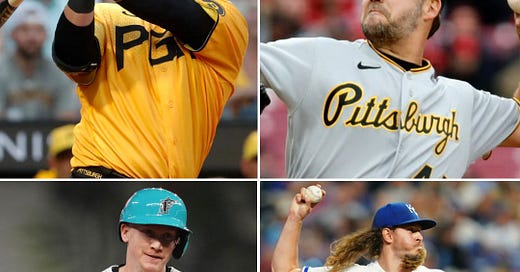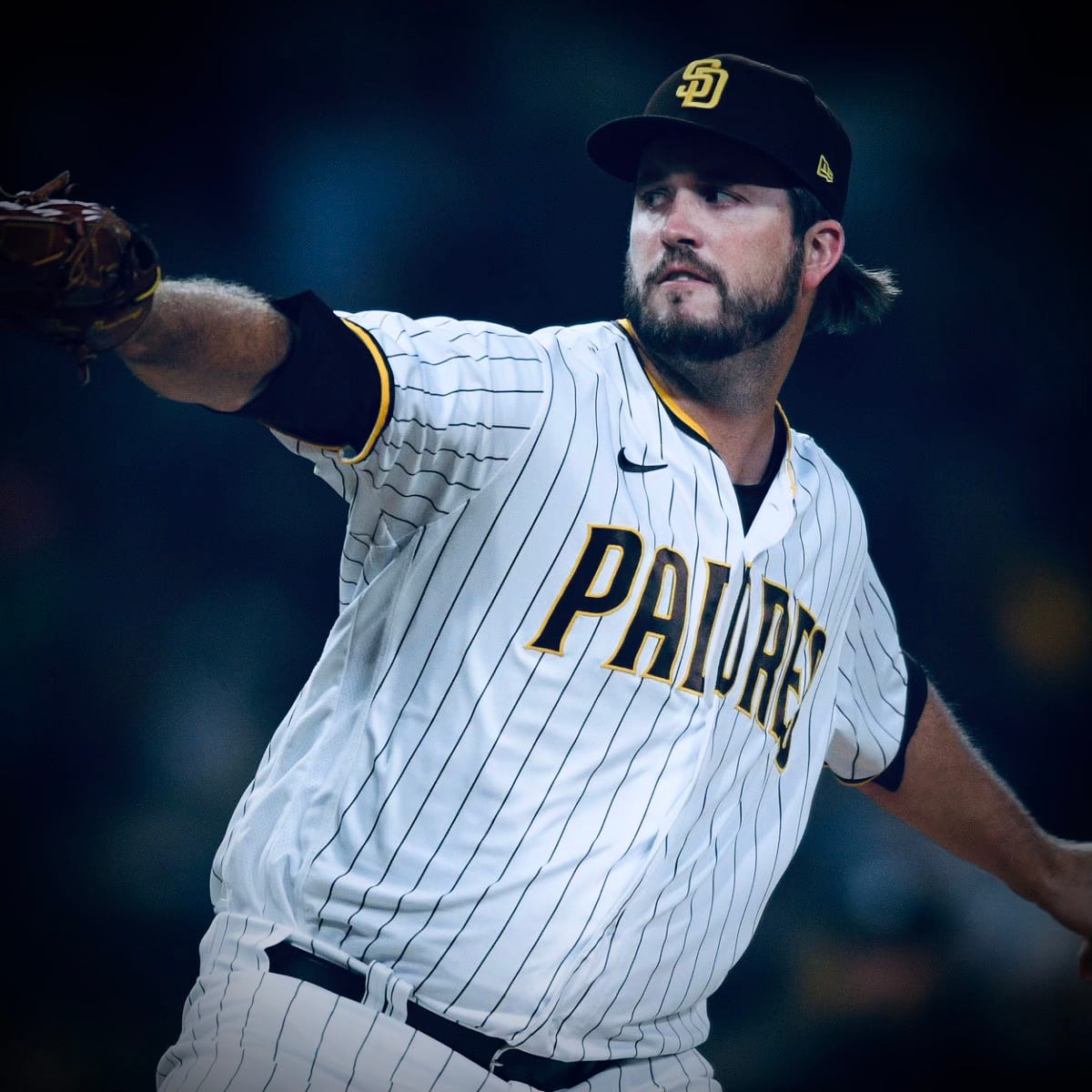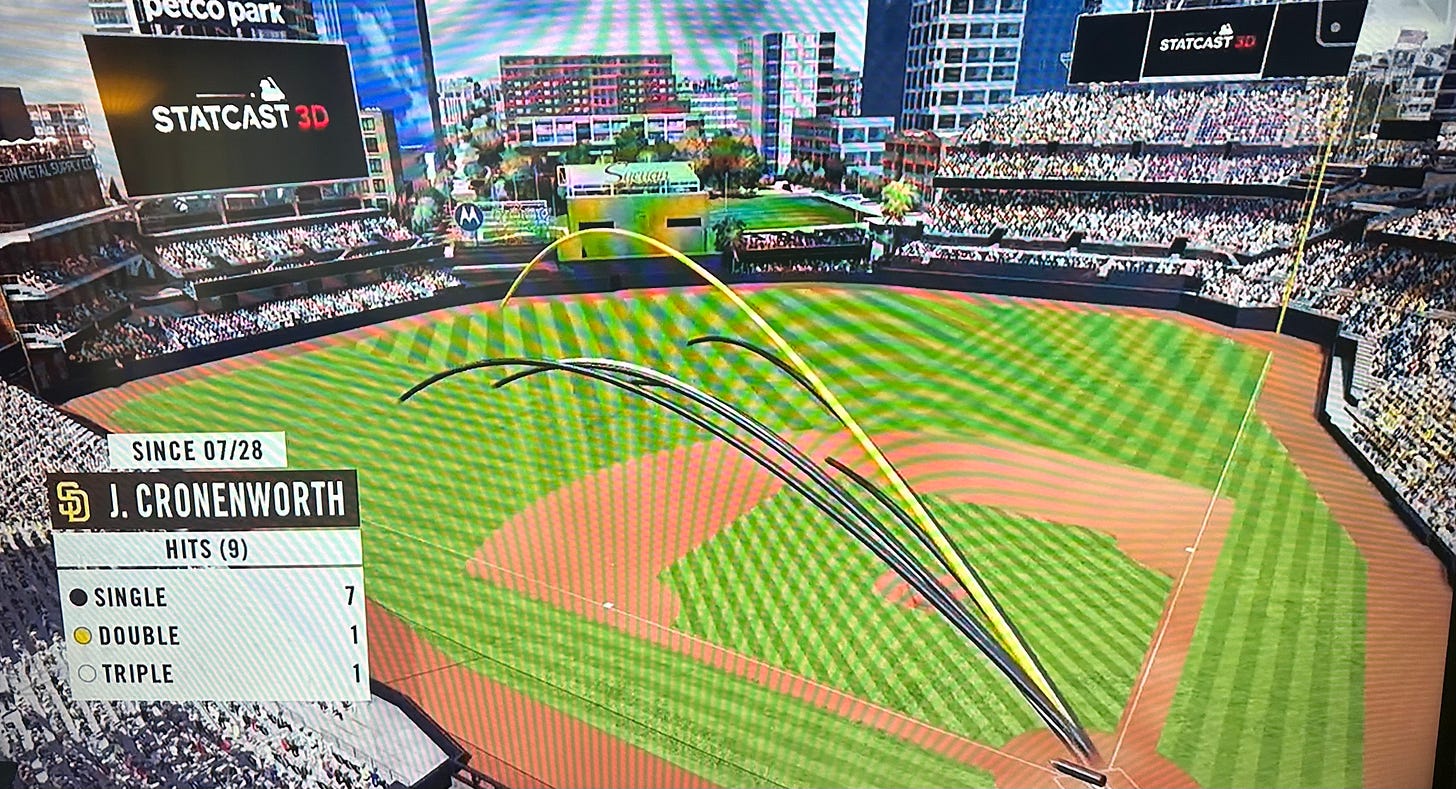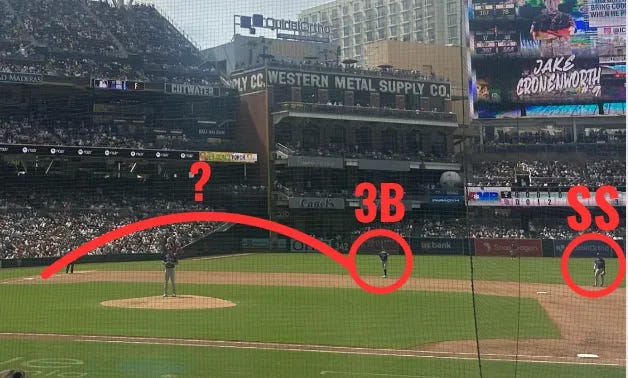On trade deadline day, 2022, the Padres were 58-46 with a +35 run differential. Their record was better than their run differential suggested. They’d gotten a little lucky, but they were good. Their biggest weakness was right field, where the job-share anchored by Nomar Mazara, Wil Meyers, and an assorted cast of characters had produced a wretched .611 OPS. The Padres addressed this weakness by making the biggest splash in trade deadline history: They acquired Juan Soto. This wasn’t just a big move; it was a franchise-defining big move.
At this year’s trade deadline, the Padres were 52-55 with a +62 run differential. Their record was much worse than their run differential suggested. Luck played a roll in this discrepancy without a doubt; no matter how flawed a process a team should not go 0-10 in extra inning games. But it wasn’t just luck, they had very discreet flaws. They had blown an astonishing 20 save opportunities, 16 of which came from overmatched middle relievers. They had been short a back of the rotation pitcher all year forcing them to march out a milieu of underwhelming arms time and again. They’ve had some of the worst DH production in baseball, getting a combined .646 OPS from that position. Finally, they had also been the worst clutch hitting team in baseball, an outcome that a rigid approach to hitting partially explained.
The trade deadline is a nervous time for those who covet prospects; prospects become capital used in the acquisition of present value when deadline deals are consummated, and no one has embraced this paradigm more than Preller. To his credit, after ‘emptying the vault’ of prospect capital to acquire Juan Soto last year, the Padres somehow still had a deep and exciting farm system with plenty of top end talent. This is a prima facie good for the organization, but also meant there was kindling for a Preller deadline conflagration. Fans lived in fear of a Jeff Passan tweet announcing that, say, Jackson Merrill and Ethan Salas had been sent to the Cardinals for Paul Goldschmidt. Those fans were presumably on pins and needles when Passan tweeted about a Padres trade on Tuesday morning:
The Padres gave up LHP Jackson Wolf, OF Estuar Suero and 1B Alfonso Rivas to get Choi and Hill.
When the clock struck midnight at 3PM PST (that’s how it works at the trade deadline), no other Padres trades had been announced. But it soon came out that Preller had made two more trades just before the deadline:
And a few minutes later:
So, when it was all said and done, the Padres got:
SP Rich Hill
Left handed 1B/DH Ji-Man Choi
Right handed 1B/OF Garrett Cooper
RP Scott Barlow
RP Prospect Sean Reynolds
And they had dealt:
LHP Jackson Wolf
RHP Henry Williams
LHP Ryan Weathers
OF Estuar Suero
1B Alfonso Rivas
RHP Jesus Rios
The Padres gave up zero players who were likely to play a role down the stretch while acquiring a few pieces who will go straight onto the gameday roster. This was about as pure of a future-value-for-present-value deadline day as you’ll see. These trades were made to address the here and now.
But how, exactly, do the new pieces fit together? It seems pretty clear what Preller was thinking…
Rich Hill will end the Sixth Starter By Not-Very-Talented Committee approach. The members of that Committee -- Ryan Weathers, Reiss Knehr, Adrián Morejón, Matt Waldron, and Jackson Wolf – combined for 14 starts and a 7.01 ERA, averaging 4.9 innings per start. This makes Hill’s 4.76 ERA look outstanding by comparison. Hill is not in San Diego to pitch important innings in the postseason; he’s a floor-raiser meant to spare the bullpen down the stretch.
Ji Man Choi is a left-handed hitting first baseman with a career .810 OPS off of right-handed pitchers. He’ll replace Matt Carpenter at DH. Carpenter has had an amazing career, but the bottom line is that his .598 OPS this year is just not playable. With Choi’s arrival, it’s unlikely that Bob Melvin will find the at-bats he claimed to be seeking for Carpenter unless it’s in a pinch hitting role.
Garrett Cooper has a career .802 OPS against left-handed pitchers, including .871 this year. He will take the ABs that had previously gone to Nelson Cruz at DH, and should make occasional starts at first (look for Crone to get some days off) and in the corner outfield spots. It’s curious that the Marlins traded him. Earlier this week, Cooper batted third for the Marlins and hit a home run; two days later, he was traded. Strange.
Scott Barlow is a hard-throwing RHP who is less hard-throwing than he used to be; his velocity has dropped in recent years. But he also has some decent breaking pitches, and those appear to be intact:
Courtesy: @TooMuchMortons_
One theory as to why Petco is such a hard park to hit in is that the dense air – which comes from the adjacency to the ocean and the temperate climate leading to cooler temperatures in the summer than other MLB parks – puts more break on breaking balls. Under this theory, Petco is basically Bizarro World Coors Field. If this theory is correct, then Barlow might fare much better with the Padres than he did with the Royals. Let’s hope so, because his ERA is currently 5.35. But even if there’s no atmospheric advantage in San Diego, there’s reason to think he’ll perform better going forward. His peripherals are much more encouraging than his results suggest: His FIP is 3.63, which is right in line with his career norms. And his K/9 is also an excellent 10.9. The defense behind him in Kansas City was atrocious, which can inflate a pitcher’s ERA. And there’s some evidence that exactly this was happening in KC: The Royals have not committed many errors, but their defensive efficiency is abysmal. That means a lot of runs score that are essentially from bad defense (think poor range and instincts), but the box score counts them as earned because they didn’t come by way of error. The Padres, on the other hand, play outstanding defense. There’s a good chance that the Padres will get the best version of Barlow and he’ll become a useful mid-leverage bullpen arm.
Sean Reynolds was one of the few players the Padres acquired who is still a pure a prospect. He’s a 6’8" former position player who converted to pitching two years ago and has found a lot of success in the minor leagues. He’s 25 and should arrive in the majors soon, probably next year.
So: The Padres needed a better bullpen, and they added Barlow and got Hill to be the for-reals sixth starter. They needed a new DH and got Choi and Cooper to form a platoon that seems capable of posing an OPS above .800, which would be a major improvement on the current .646 mark. The Padres addressed the team’s weaknesses without sacrificing prospect capital.
It’s a G.M.’s (or President of Baseball Operations’) responsibility to know the team’s strengths and weaknesses. The moves a G.M. makes at the deadline can demonstrate their understanding, or lack thereof. Preller’s reputation on this metric is not stellar; he’s sometimes seen as a G.M. who chases star power and ignores roster construction. But Preller’s 2023 deadline moves go against that perception. He patched leaks and avoided big moves. He didn’t ship out any top prospects. It looks like Preller understood his team and addressed its weaknesses. That might be growth. Lessons learned from a decade of capricious decision making may be providing deliverance from a chaotic season. We can hope.
Dare to dream
The one need that the Padres couldn’t fill was another hard-throwing lefty reliever. Barlow should give right handed batters trouble, but has worse platoon splits against lefties. Cosgrove and Tim Hill work more with craft than stuff. Hader remains the only lefty power arm. Inevitably, some fans will dare to dream that this final missing piece is closer than we realize; we’ll imagine that he’s out there, unseen, engaged in some kind of Rocky-meets-Luke-Skywalker-on-Dagobah training regimen. Clandestinely rebuilding a broken body… waiting for the perfect moment to rejoin the ranks of the living…
Look, no one should think this is actually going to happen. But if it did…
The One Other Thing
The one thing the Preller was never going to be able to fix at the trade deadline was the Padres’ poor performance in the clutch. Jake Cronenworth, for one, has experienced almost unbelievable struggles in the clutch. But, though Preller couldn’t fix this problem, there may be some hope in the fact that Cronenworth has seemed different lately. Entering Wednesday he’d strung together five straight multi-hit games – here’s a graphic from Tuesday’s broadcast:
Cronenworth is hitting to the opposite field. The short, compact swing that he showcased in his first two years in the league seems to have returned. And that approach makes a lot of sense when teams are defending you like this:
Team’s take this defensive tack when a hitter has been eschewing an opposite field approach. But Jake Cronenworth is working on his craft. Here’s an example of how Cronenworth attacked that defensive alignment:
Courtesy: @TooMuchMortons_
That’s from the game against the Rangers on Sunday. Crone had two hits in every game that series, but the Rangers stuck with their defensive approach. If Cronenworth is able to recapture the ability to hit well to all fields, there will be a defensive inefficiency to exploit if teams play him as a dead-pull hitter.
It does look like the Rockies noticed the change in Crone’s approach however. They’ve played the shortstop in a more neutral alignment with the third baseman closer to the line. But Cronenworth is still seeing success:
That swing came on a 2-1 count; earlier in the season, it seems likely that Cronenworth would have swung for the fences. This time, he put a short swing on the ball and hit a line drive. This was Cronenworth channeling his inner Tony Gwynn, which is an approach well-suited to high-leverage situations. It’s hard to know if this is truly a mid-season transformation. It sure looks like Cronenworth is making a concerted effort to return to the high-contact, use the entire field, approach that was so successful in the past. If this transformation is real, there is reason to think that at least Cronenworth will improve his hitting in the clutch down the stretch.
The Pressure’s On, But The Pressure Is Off
Early in the season, it looked like the Padres were collapsing under the weight of expectations. If that was true, then the opposite should now be true, because most people have written this team off. There are no expectations. And in this new environment…the Padres are competing. They’re clawing their way back to .500. The trade deadline deals addressed some of the weaknesses that have been holding the team back, and they did so without sacrificing the future. The clutch woes remain a nebulous concern, but at least there is some tangible evidence that one of the team’s weakest hitters in this regard is working on an approach much better suited to high-leverage at bats. The trade deadline is no longer a source of anxiety. Those advocating to be sellers can shake hands with those who wanted to buy. Making the postseason remains a long shot, but the way forward is clear. For now, we can all sit back and watch this team try to shoot the moon.









